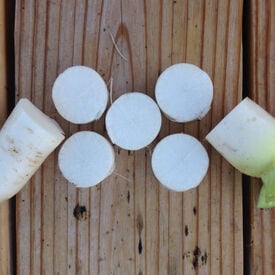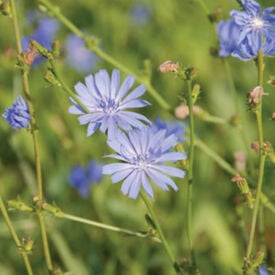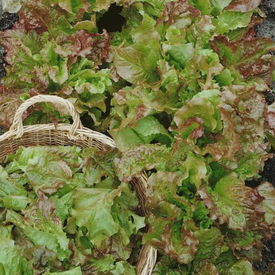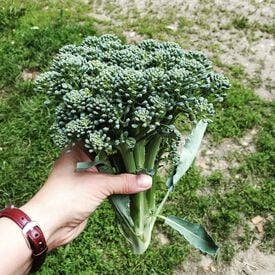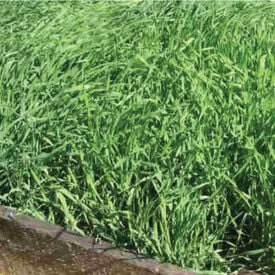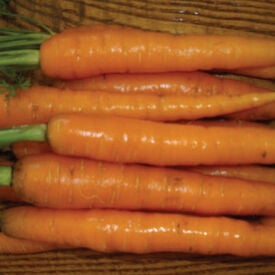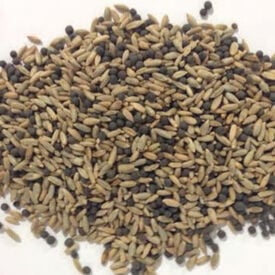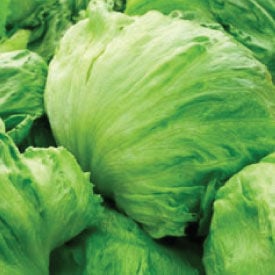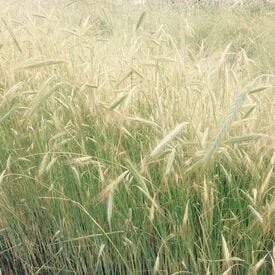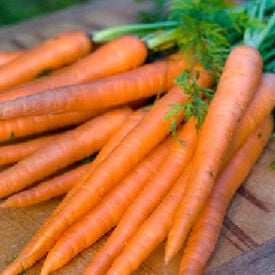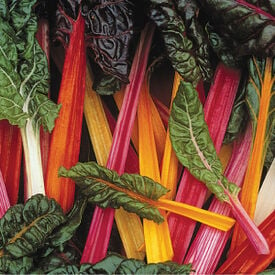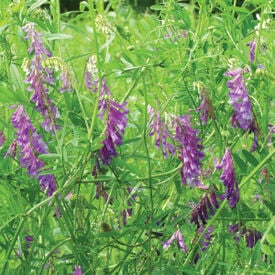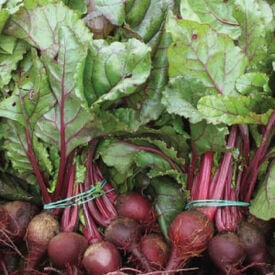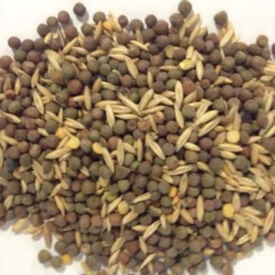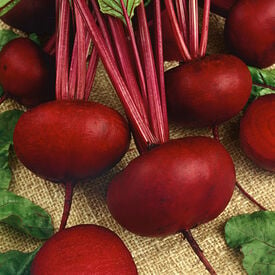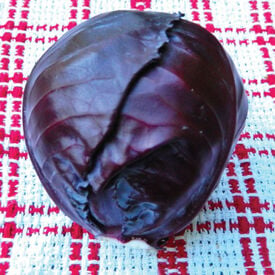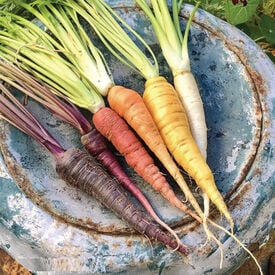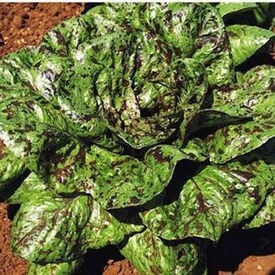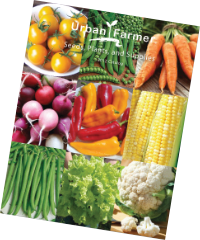Minowase radish seeds produce a classic Japanese daikon variety with origins in East Asia, where long-rooted radishes have been cultivated for centuries for their productivity and versatility. Known for its smooth white roots that often reach 12–18 inches, Minowase features crisp, juicy flesh with a mild, slightly sweet, lightly peppery flavor that is far gentler than smaller spring radishes. Its clean taste and firm texture make it ideal for microgreens, sprouts, salads, pickling, stir-fries, soups, fermenting, and even grating fresh as a condiment. This variety grows best in cool weather and loose, deeply prepared soil that allows for long, straight roots; sow seeds directly in late summer or early fall, provide consistent moisture, thin seedlings to prevent crowding, and harvest before hard frosts for the best quality.
Chicory has a long taproot that penetrates subsoils which makes it drought tolerant and allows it to make minerals more available to livestock. Rich in potassium, sulfur, calcium, zinc, sodium, manganese and iron. When managed properly, Chicory produces leafy growth which is higher in nutritive and mineral content than alfalfa and other cool season grasses. Used mainly in mixes with other pasture or cover crop seeds. Chicory (Cichorium intybus L.) - Warm season, broadleaf - Perennial - Upright and spreading growth habit - Protein levels: 10-32% - Forms arbuscular mycorrhizal associations Uses: - Bees & Beneficial Insects - Chicken Forage - Deer Attractant - Forage
The Santa Fe Lettuce produces a small blanched head that is surrounded by green outer leaves with a tinged bronze-red tip. This variety is a favorite for being extra crunchy!
Waltham 29 produces incredibly high yields for broccoli! This variety is known for its good color, cold resistance, dwarf compact plant, and big side shoots. Main heads are 4-8" with steady side shoot production after main head is harvested.
The Elbon Rye is a grain that is the best choice for fast, cool-season germination that prevents erosion and builds organic matter in the soil! Plant this variety early to late fall; in mild climates fall through early spring. This grain captures soil nutrients in the fall to release in spring when worked into the soil. The Elbon Rye can reach up to 5 feet! Cereal Rye (Secale cereale L.): Cool season, grass, Annual or perennial, Upright plant growth, Crude protein: straw 4%, grain 14%, C:N ratio: 40-48, Self pollinator (wind) Uses: Erosion Control, Green Manure, Nitrogen Scavenger, No Till, Organic Matter (Biomass), Weed suppression
The Scarlet Nantes is popular as a sweet baby, slicer, or fresh market variety. A sweet and tender carrot with a cylindrical shape and blunt-tip. Scarlet Nantes have a bright orange-red color throughout. Very popular variety of carrot for eating fresh or cooked. Slow bolting and very popular among gardeners.
Great way to fix nitrogen and add organic matter to the soil! A great mix of grass and legume cover crops. Hairy Vetch works well for nitrogen fixation while Rye adds organic matter and protects the less hardy vetch from winter damage. If planted in fall it comes back early spring with heavy growth. Cut right after it flowers and spring and till into soil. (75% Winter Rye / 25% Hairy Vetch) Seed Coverage: - 5 lbs covers 2,000-4,000 sqaure feet - 100 lbs covers 1-2 acres Uses: Deer Attractant, Green Manure, Nitrogen Fixation, No Till, Organic Matter (Biomass), Weed Suppression
Iceberg Lettuce is the tried and true lettuce that is an easy to grow, slow bolting crisphead. This variety has proven to be one of the most popular crispheads for years! Iceberg is a great lettuce that performs exceptionally well under warm weather conditions. This compact lettuce plant features better leaf texture and quality than other varieties. This variety resists rib discoloration and tip burn.
The Winter Rye is a tall grain cover crop that can reach up to be 5 feet tall and prevents erosion and builds organic matter in the soil. This grain can be planted early to late fall and in mild climates, fall through early spring. This grain is the best choice for fast, cool-season germination. The Winter Rye captures soil nutrients in the fall to release in spring when worked into the soil. Uses: Erosion Control, Green Manure, Nitrogen Scavenger, No Till, Organic Matter (Biomass), Weed suppression
The Danver 126 is a durable, multipurpose carrot that produces high yields. Danver 126 was bred by the Eastern States Farmers Exchange from selections of heat resistant strains of carrots. This carrot is improved for better interior color, smoother skin, better uniformity and better yield. Released in 1947. Excellent for home gardens and markets.
Bright Lights is such a beautifully colored and tasty Swiss Chard! This chard produces stalks of orange, red, white, and pink! Bright Lights will grow up to 20 inches.
When sown late summer, the Hairy Vetch spring regrowth is vigorous and nitrogen-producing, for tilling in before planting spring garden crops. You can sow with or without grain, grass or field peas! The typical nitrogen produced of this legume is 100 lbs. per acre. The Hairy Vetch has rapid growth that makes it a good weed suppressant. Uses: Bees & Beneficial Insects, Chicken Forage, Deer Attractant, Erosion Control, Forage, Green Manure, Nitrogen Fixation, No Till, Weed Suppression
The Early Wonder beet is a popular heirloom beet plant that produces high yields of deep red roots! A popular beet that is tasty, early maturing and produces abundant greens. The beets are great for boiling, pickling, baking, and freezing. Forms 3-4" deep red globes that are sweet and tender. Also known as "Tall Top" for its tall, glossy leaves that make great greens with salads. Greens are also a great substitute for chard or spinach and have high vitamin A and C.
Using the Field Peas and Oats Blend throughout your garden is a great way to fix nitrogen and add organic matter to the soil! This blend contains a great ratio of grass and legume cover crop for fixing nitrogen, winter cover, weed suppression and more. The Field Peas and Oats Blend should be sown from early spring to late summer. Sow no later than 6 weeks before first fall frost in your area. This variety is gold hardy enough to grow long into the fall leaving behind a great mulch for soil protection. (75% peas / 25% oats by weight) Seed Coverage: - 5 lbs covers 2,000-4,000 sqaure feet - 100 lbs covers 1-2 acres Uses: Deer Attractant, Green Manure, Nitrogen Fixation, No Till, Organic Matter (Biomass), Weed Suppression
The Crosby Egyptian beet is a standard early bunching beet for table or market, a favorite that is now also available in organic seeds. The flattened heart-shaped roots and dark-red flesh of this beet is equally appetizing as it is beautiful. The Crosby Egyptian is also the largest early variety beet and will keep its shape until fall. Enjoy both the roots and the tops chopped up in a salad! Certified Organic. Learn more about our organic seeds.
Red Acre cabbage is simply the best early maturing red cabbage! Red Acre is a fantastic cabbage that produces reddish-purple heads. Each cabbage head grows to 7 inches in diameter and weighs about 3 pounds. Red Acre is resistant to cabbage yellowing and is great for home gardens that have little space. Red Acre cabbage stores better than just about any other early cabbage variety. Great raw or for coleslaw use.
The rainbow mix is a blend of our favorite bright heirloom carrots! Mix of every imaginable carrot color, purple, red, white, even some orange. Purple has smooth skin, coreless orange flesh and is sweet and tasty. Yellow holds its sunny hue inside and out, is crunchy, sweet and juicy. White is mild and delicious, and Red has high lycopene levels as well as a crispy texture that is great cooked. Enjoy these delicious carrots cooked or raw.
Freckles Lettuce gets its name for being an unusual bright green romaine lettuce with crimson freckles! This uniquely colored lettuce is sun-loving and grows upright. This variety has a crisp texture that can be harvested early or late!
